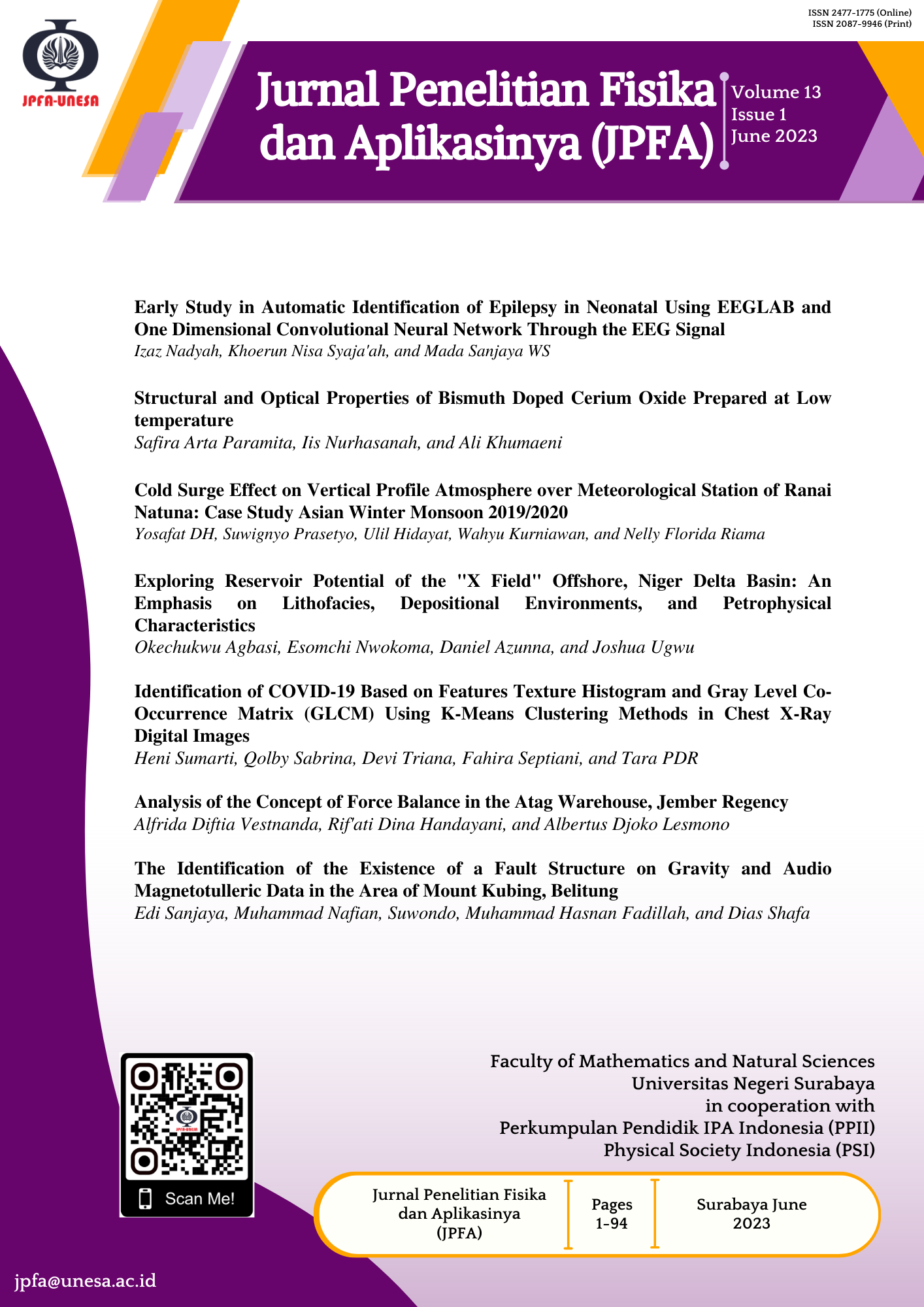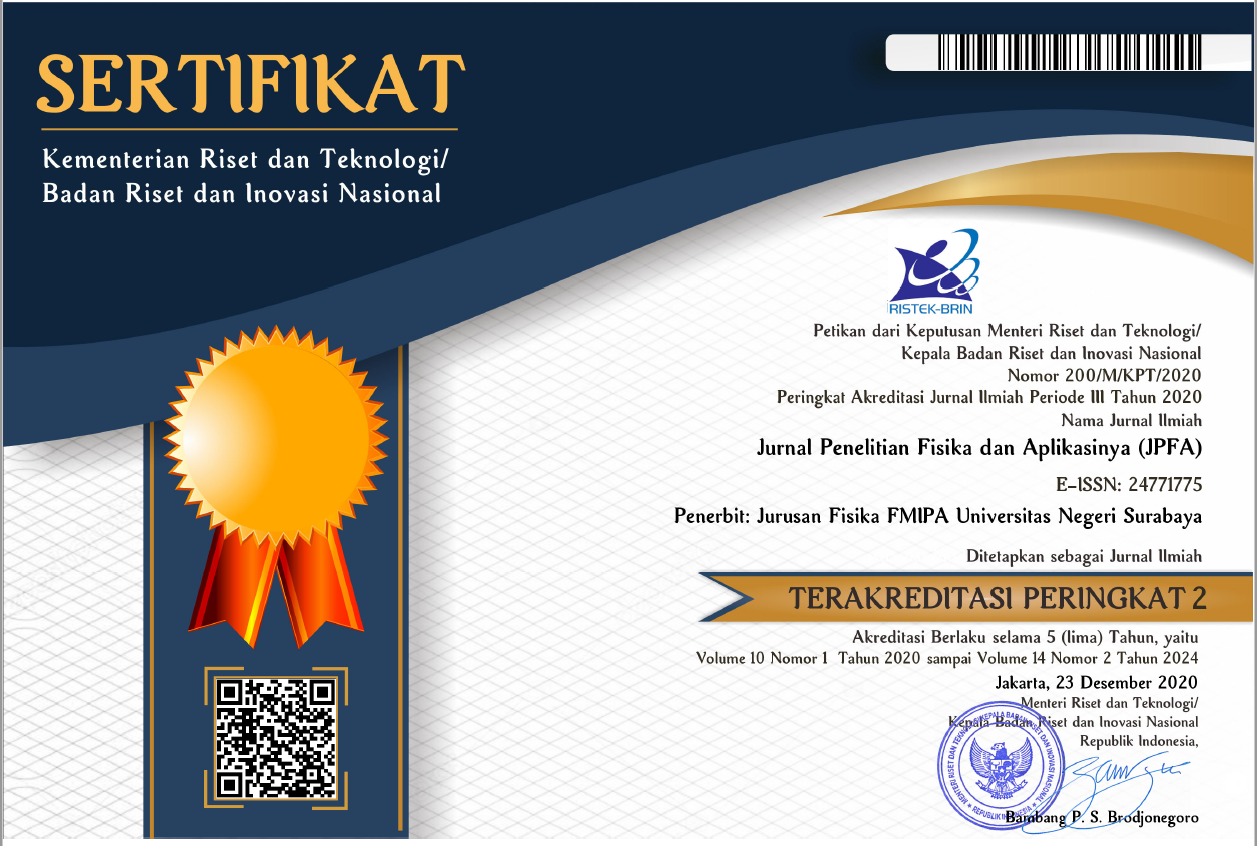Early Study in Automatic Identification of Epilepsy in Neonatal Using EEGLAB and One Dimensional Convolutional Neural Network Through the EEG Signal
DOI:
https://doi.org/10.26740/jpfa.v13n1.p1-15Keywords:
Confusion Matrix, EEG, EEGLAB, EpilepsyAbstract
In detecting epileptic activity, medical experts examine the visual result of Electroencephalography signals. The visual analysis will take a lot of time and effort, due to a large amount of data. Furthermore, there are some errors in concluding the analysis result. One of the ways to analyze this quickly is to use Machine Learning (ML) methods. This study aims to evaluate the performance of 1D-CNN in identifying the given data. First, the signal will go through pre-processing using EEGLAB Toolbox which is then classified to identify epilepsy and non-epilepsy with the 1D-CNN algorithm. The results showed that the proposed method obtained high accuracy values, respectively 99,078% for the training data and 82,069% for the validation results. From the evaluation by a confusion matrix, an average accuracy of 99,31% was obtained. Based on this evaluation, the proposed model can be used as an efficient method in the process of automatic classification, detection, or identification of epileptic activity.
References
Kusumastuti K and Basuki M. Definisi, Klasifikasi dan Etiologi Epilepsi. 5th Edition. Surabaya: Airlangga University Press; 2014.
Wibowo D S. Buku Kedokteran EGC: Neuroanatomi Klinis. 2nd Edition. Jakarta: Erlangga; 2014.
Leah B. What We Know Now About Epilepsy and Covid-19. Available from: https://www.epilepsy.com/stories/what-we-know-now-about-epilepsy-and-covid-19.
Epilepsy Foundation. Update on Covid-19 and People with Epilepsy. Available from: https://epilepsylosangeles.org/international-league-against-epilepsy-ilae-shares-update-on-covid-19-and-people-with-epilepsy/.
World Health Organization (WHO). Epilepsy: Key facts. Available from: https://www.who.int/news-room/fact-sheets/detail/epilepsy [accessed 18 August 2022].
Delanty N. Complex Detection, Complex Decisions: More Detail on Subclinical Seizure in the Acutely Sick Brain. Epilepsy Currents. 2014; 14(3): 129-130. DOI: https://doi.org/10.5698/1535-7597-14.3.129.
Elakkiya R. Machine Learning Based Intelligent Automated Neonatal Epileptic Seizure Detection. Journal of Intelligent & Fuzzy Systems. 2021; 40(5): 8847-8855. DOI: https://doi.org/10.3233/JIFS-200800.
Al-Hadeethi H, Abdulla S, Diykh M, Deo RC, and Green JH. Adaptive Boost LSSVM Classification Approach for Time-Series Signal Classification in Epileptic Seizure Diagnosis Applications. Expert Systems with Applications. 2020; 161(14): 113676. DOI: https://doi.org/10.1016/j.eswa.2020.113676.
Tanveer MA, Khan MJ, Sajid H, and Naseer N. Convolutional Neural Networks Ensemble Model for Neonatal Seizure Detection. Journal of Neuroscience Methods. 2021; 358: 109197. DOI: https://doi.org/10.1016/j.jneumeth.2021.109197.
Birjantalab J, Pouyan MB, Cogan D, Nourani M, and Harvey J. Automated Seizure Detection Using Limited-Channel EEG and Non-Linear Dimension Reduction. Computers in Biology and Medicine. 2017; 82: 49-58. DOI: https://doi.org/10.1016/j.compbiomed.2017.01.011.
Shankar RS, Raminaidu CH, Raju VVS, and Rajanikanth J. Detection Epilepsy based on EEG Signals using PCA with ANN Model. Journal of Physics: Conference Series. 2021; 2070: 012145. DOI: https://doi.org/10.1088/1742-6596/2070/1/012145.
Krishnaprasanna R and Baskar VV. Focal and Non-Focal EEG Signal Classification by Computing Area of 2D-PSR Obtained for IMF. Journal of ICT Standardization. 2017; 5(2): 171-186. DOI: https://doi.org/10.13052/jicts2245-800X.523.
Saleh AY and Xian LK. Stress Classification using Deep Learning with 1D Convolutional Neural Networks. Knowledge Engineering and Data Science. 2021; 4(2): 145-152. DOI: https://doi.org/10.17977/um018v4i22021p145-152.
Hinton GE, Osindero S, and Teh YW. A Fast Learning Algorithm for Deep Belief Nets. Neural Computation. 2006; 18(7): 1527-1554. DOI: https://doi.org/10.1162/neco.2006.18.7.1527.
Putra SR. Implementasi Convolutional Neural Network Untuk Klasifikasi Obyek Pada Citra. Undergraduate Thesis. Published. Surabaya: Institut Teknologi Sepuluh Nopember; 2015.
Wei X, Zhou L, Zhang Z, Chen Z, and Zhou Y. Early Prediction of Epileptic Seizures using A Long-Term Recurrent Convolutional Network. Journal of Neurosciece Methods. 2019; 327: 108395. DOI: https://doi.org/10.1016/j.jneumeth.2019.108395.
Jana GC, Sharma R, and Agrawal A. A 1D-CNN-Spectrogram Based Approach for Seizure Detection from EEG Signal. Procedia Computer Science. 2020; 167: 403-412. DOI: https://doi.org/10.1016/j.procs.2020.03.248.
Sagga D, Echtioui A, Khemakhem R, and Ghorbel M. Epileptic Seizure Detection using EEG Signals based on 1D-CNN Approach. 2020 20th International Conference on Science and Techniques of Automatic Control and Computer Engineering (STA). 2020: 51-56. DOI: https://doi.org/10.1109/STA50679.2020.9329321.
Delorme A and Makeig S. EEGLAB: An Open-Source Toolbox for Analysis of Single-Trial EEG Dynamics Including Independent Component Analysis. Journal of Neuroscience Methods. 2004; 134(1): 9-21. DOI: https://doi.org/10.1016/j.jneumeth.2003.10.009.
Stevenson NJ, Tapani K, Lauronen L, and Vanhatalo S. A Dataset of Neonatal EEG Recordings with Seizure Annotations. Scientific Data. 2019; 6: 190039. DOI: https://doi.org/10.1038/sdata.2019.39.
Kusuma DT. Fast Fourier Transform (FFT) dalam Transformasi Sinyal Frekuensi Suara Sebagai Upaya Perolehan Average Energy (AE) Musik. PETIR: Jurnal Pengkajian dan Penerapan Teknik Informatika. 2021; 14(1): 28-35. DOI: https://doi.org/10.33322/petir.v14i1.1022.
Anggoro DA and Supriyanti W. Improving Accuracy by Applying Z-Score Normalization in Linear Regression and Polynomial Regression Model for Real Estate Data. International Journal of Emerging Trends & Technology in Computer Science. 2019; 7(11): 549-555. DOI: 10.30534/ijeter/2019/247112019.
Stevenson NJ, Tapani K, Lauronen L, and Vanhatalo S. A Dataset of Neonatal EEG Recordings with Seizure Annotations. Switzerland: Zenodo; 2018. DOI: https://doi.org/10.5281/zenodo.1280683.
Niedermeyer E and da Silva FHL. Electroencephalography: Basic Principles, Clinical Applications, and Related Field. Philadelphia: Lippincott Williams & Wilkins; 2005.
Pedregosa, F, et al. Scikit-learn: Machine Learning in Python. Journal of Machine Learning Research. 2011; 12(85): 2825-2830. Available from: https://jmlr.org/papers/v12/pedregosa11a.html.
Moghaddari M, Lighvan MZ, and Danishvar S. Diagnose ADHD Disorder in Children using Convolutional Neural Network based on Continuous Task EEG. Computer Methods and Programs in Biomedicine. 2020; 197: 105738. DOI: https://doi.org/10.1016/j.cmpb.2020.105738.
Wu MT. Confusion Matrix and Minimum Cross-Entropy Metrics based Motion Recognition System in The Classroom. Scientifict Report. 2022; 12: 3095. DOI: https://doi.org/10.1038/s41598-022-07137-z.
Gupta, D, Kose U, Khanna A, and Balas VE. Deep Learning for Medical Applications with Unique Data. US: Academic Press; 2022. DOI: https://doi.org/10.1016/C2020-0-00679-1.
Luck SJ. An Introduction to The Event-Related Potential Technique. London: MIT Press; 2014.
Demuru M, La Cava SM, Pani SM, and Fraschini M. A Comparison Between Power Spectral Density and Network Metrics: An EEG Study. Biomedical Signal Processing and Control. 2020; 57: 101760. DOI: https://doi.org/10.1016/j.bspc.2019.101760.
Shin T. How I Consistently Improve My Machine Learning Models From 80% to Over 90% Accuracy. Available From: https://towardsdatascience.com/how-i-consistently-improve-my-machine-learning-models-from-80-to-over-90-accuracy-6097063e1c9a [accessed 23 October 2022].
Tu ?rk O ? and O ?zerdem MS. Epilepsy Detection by Using Scalogram Based Convolutional Neural Network from EEG Signals. Brains Sciences. 2019; 9(5): 115. DOI: https://doi.org/10.3390/brainsci9050115.
Hassan F, Hussain SF, and Qaisar SM. Epileptic Seizure Detection Using a Hybrid 1D CNN-Machine Learning Approach from EEG Data. Journal of Healthcare Engineering. 2022; 2022: 9579422. DOI: https://doi.org/10.1155/2022/9579422.
Downloads
Published
How to Cite
Issue
Section
License
Copyright (c) 2023 Jurnal Penelitian Fisika dan Aplikasinya (JPFA)

This work is licensed under a Creative Commons Attribution-NonCommercial 4.0 International License.
Author(s) who wish to publish with this journal should agree to the following terms:
- Author(s) retain copyright and grant the journal right of first publication with the work simultaneously licensed under a Creative Commons Attribution-Non Commercial 4.0 License (CC BY-NC) that allows others to share the work with an acknowledgement of the work's authorship and initial publication in this journal for noncommercial purposes.
- Author(s) are able to enter into separate, additional contractual arrangements for the non-exclusive distribution of the journal's published version of the work (e.g., post it to an institutional repository or publish it in a book), with an acknowledgement of its initial publication in this journal.
The publisher publish and distribute the Article with the copyright notice to the JPFA with the article license CC-BY-NC 4.0.
 Abstract views: 985
,
Abstract views: 985
, PDF Downloads: 955
PDF Downloads: 955









